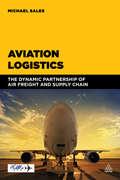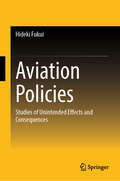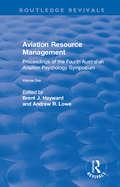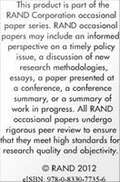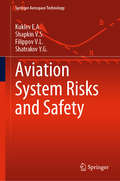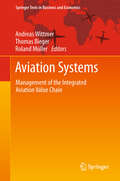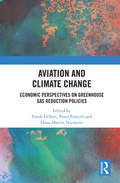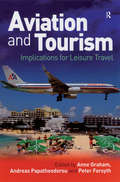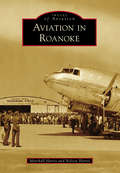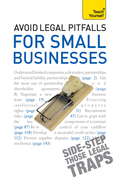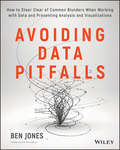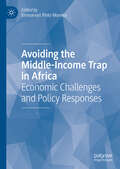- Table View
- List View
Aviation Logistics
by Michael SalesAviation Logistics looks at the function of the air cargo business and its role in global supply chains and logistics. As global economies are constantly evolving, the supply chain business with its transport partners must be proactive for the future. Technology and its resulting efficiency and transparency are therefore a central part of this book. Aviation Logistics examines how carriers are coming up with new methods and technologies to improve ground handling and road transport, traceability systems and barcoding, security and screening, and safe delivery of perishable items (such as in the pharmaceutical and medical sectors). Endorsed by The International Air Cargo Association (TIACA), Aviation Logistics is supplemented with case studies and contributions from a team of experts including Oliver Evans and Stan Wraight, both industry experts.
Aviation Pioneers of Canada 7-Book Bundle: Brace for Impact / Air Canada / and 5 more
by Peter PigottThe Aviation Pioneers of Canada 7-Book Bundle presents the high-flying insight of Peter Pigott, in a special collection chronicling the aviators, aircraft, and drama of over a century of Canadian flight. From the Avro Arrow and the Silver Dart to the adventurers and visionaries who pushed Canadian airways to new heights, Pigott covers it all with his trademark breezy style and incredible historical photographs. Includes Brace for Impact: Air Crashes and Aviation Safety Air Canada: The History Flying Canucks: Famous Canadian Aviators Flying Canucks II On Canadian Wings: A Century of Flight Taming the Skies: A Celebration of Canadian Flight Wings Across Canada: An Illustrated History of Canadian Aviation
Aviation Policies: Studies of Unintended Effects and Consequences
by Hideki FukuiThis book sheds new light on aviation policies&’ unintended effects and consequences, especially regarding infrastructure, environment, and consumer protection. The book provides the reader with the first systematic quantitative analyses of the impacts of airlines&’ strategic reactions to the introduction of airport slot markets, aviation fuel tax, and consumer protection rules. Through extensive empirical investigations, the author reveals that aviation policies based on the regulations and tax can produce both intended and unintended effects and consequences. Although the introduction of airport slot markets was expected to enhance airline competition, airlines&’ manipulative behaviors have impeded the slot markets&’ effective functioning. Also, the aviation fuel tax can reduce emissions in the air transport market effectively, but the amount of the reduction of fuel consumption and CO2 emissions would be smaller in the longer term due to the rebound effect. Finally, the consumer protection rules, e.g., the tarmac delay rule of the US Department of Transportation (DOT) significantly reduced tarmac delays; however, the DOT&’s investigations of tarmac delay incidents triggered the investigated airlines&’ risk-averse behavior, which increased flight cancelations and gate departure delays to avoid violating the rule. The analyses suggest that the most effective way of regulation depends on conditions unique to each policy area; the government should design interventions that circumvent strategic behaviors of subjects or groups that the interventions affect. This book is highly relevant to academics and practitioners interested in understanding the interactive effects between policy interventions and firms&’ strategic reactions.
Aviation Project Management
by Dennis Lock Triant G. FlourisCombining the considerable respective expertise of Triant Flouris and Dennis Lock, this unique book highlights the ways that successful businesses are managed in the aviation industry through the identification and application of proven project management methods. Theoretical concepts are defined, clarified and shown how they can be valuable to business managers and students of the aviation business sector. Aviation Project Management builds on the successful and popular work of Dennis Lock but is considerably enhanced by applications, examples, illustrations and case examples pertaining to projects exclusively from the aviation industry. Theory in the project management field is already well evolved, so the purpose of this book is not to review that theory but rather to demonstrate how the lessons of theory can be of practical use to aviation students and business managers. It provides a practical guide to those interested in how projects are managed and the common mistakes that aviation project managers should avoid.
Aviation Resource Management: Proceedings of the Fourth Australian Aviation Psychology Symposium Volume 1 (Routledge Revivals)
by BRENT J. HAYWARD AND ANDREW R. LOWEThis title was first published in 2000. This is volume one of a two-volume set which presents the reader with strategies for the contributions of psychology and human factors to the safe and effective functioning of aviation organizations and systems.Together, the volumes comprise the edited contributions to the Fourth Australian Aviation Psychology Symposium. The chapters within are orientated towards presenting and developing practical solutions for the present and future challenges facing the aviation industry. Each volume covers areas of vital and enduring importance in the complex aviation system. Volume one includes aviation safety, crew resource management, the aircraft cabin, cockpit automation, safety investigation, fatigue and stress, and applied human factors in training.
Aviation Security: After Four Decades, It's Time for a Fundamental Review
by Brian Michael JenkinsAviation Security: After Four Decades, It's Time for a Fundamental Review
Aviation System Risks and Safety (Springer Aerospace Technology)
by Shatrakov Y.G. Kuklev E.A. Shapkin V.S. Filippov V.L.This book provides a solution to “rare event” problems without using the classical theory of reliability and theory of probability. This solution is based on the methodology of risk assessment as “measure of danger” (in keeping with the ICS RAS) and an expert approach to determining systems’ safety indications using Fuzzy Sets methods. Further, the book puts forward a new concept: “Reliability, Risks, and Safety” (RRS). The book’s main goal is to generalize present results and underscore the need to develop an alternative approach to safety level assessment and risk management for technical (aviation) systems in terms of Fuzzy Sets objects, in addition to traditional probabilistic safety analysis (PSA). The concept it proposes incorporates ICAO recommendations regarding proactive system control and the system’s responses to various internal and external disturbances.
Aviation Systems: Management of the Integrated Aviation Value Chain (Classroom Companion: Business)
by Andreas Wittmer Thomas Bieger Roland MüllerThis book provides an overview of the aviation sector by focusing on all major aspects embedded in the environment (subsystems) and the market of aviation. The book explains the linkages between subsystems politics, society, technology, economy, environment, and regulation, and how these subsystems influence each other and the market. The book starts by describing the aviation system, then focuses on the supply side and the demand side of the system and in a final part focuses on steering and controlling the system of aviation from a managerial, economic, and regulatory perspective. Examples and case studies of airports, airlines, and the production industry in each chapter support the application-oriented approach. The summary and review questions help the reader to understand the focus and main messages of each chapter. Students and researchers in business administration with a focus on aviation, as well as professionals in the industry looking to refresh or broaden their knowledge in the field will benefit from this book.
Aviation Systems: Management of the Integrated Aviation Value Chain (Springer Texts in Business and Economics)
by Andreas Wittmer Thomas Bieger Roland MüllerThis book aims to provide comprehensive coverage of the field of air transportation, giving attention to all major aspects, such as aviation regulation, economics, management and strategy. The book approaches aviation as an interrelated economic system and in so doing presents the "big picture" of aviation in the market economy. It explains the linkages between domains such as politics, society, technology, economy, ecology, regulation and how these influence each other. Examples of airports and airlines, and case studies in each chapter support the application-oriented approach. Students and researchers in business administration with a focus on the aviation industry, as well as professionals in the industry looking to refresh or broaden their knowledge of the field will benefit from this book.
Aviation and Climate Change: Economic Perspectives on Greenhouse Gas Reduction Policies
by Peter Forsyth Hans-Martin Niemeier Frank FichertThis book analyses the political, economic and managerial challenges for policy makers and the air transport industry as they face climate change. Based on an overview of the scientific background and technological options for emissions reduction, Aviation and Climate Change provides an in-depth assessment of environmental regulation and management. It provides an up-to-the-minute analysis of the effects of aviation on climate change, and an economic analysis of policies to reduce or eliminate greenhouse gas emissions. The main emphasis of the book is on the economic mechanisms used to lessen emissions – carbon taxes, emissions trading schemes and offset schemes. It pays particular attention to the ways these policies work, and to the interaction between them – for instance, the interaction between taxes and emissions trading schemes. One feature of the book is that it analyses the Carbon Offsetting and Reduction Scheme for International Aviation (CORSIA) which has been developed by ICAO for international aviation, and which is due to commence operation shortly. The advantages and disadvantages of this controversial scheme are discussed. This book will be of interest to researchers in diverse areas (economics, political science, engineering, natural sciences), to air transport policy makers, and to managers in the aviation industry.
Aviation and Tourism: Implications for Leisure Travel
by Peter Forsyth Anne Graham Andreas PapatheodorouTransport is an essential element of tourism, providing the vital link between the tourist generating areas and destinations. Good accessibility, which is determined by the transport services provided, is a fundamental condition for the development of any tourist destination. Moreover the transport industry can be a major beneficiary of tourism because of the additional passenger demand that may be generated. Aviation is an increasingly important mode of transport for tourism markets. Whilst geography has meant that, in modern times, air travel has always been the dominant mode for long distance travel and much international tourism, moves towards deregulation, and in particular the emergence of the low cost carrier sector, have also increased aviation's significance for short and medium haul tourism trips. Thus developments in aviation can have very major implications for many leisure and business tourism markets. However the characteristics and needs of leisure travellers are generally so very different from business travellers that this necessitates a separate consideration of these markets if a detailed understanding of the relationship with aviation is to be gained. In spite of the obvious closeness between the aviation and tourism industries, there are very few specialist texts on this subject. Most tourism focused books consider aviation as just one component of the tourism industry which needs to be discussed, whereas aviation specialist texts rarely concentrate on just leisure travel. In addition there is very little literature that gives a detailed appreciation of the complexities and potential conflicts associated with the development of coherent and effective aviation and tourism policies. Therefore it is the aim of this book to fill this important gap which exists with a comprehensive, in-depth study of the relationship between aviation and leisure travel. The book deals exclusively with issues related to the relationship between aviation and leisure travel. It does this with an analysis of the theoretical concepts relevant to the subject area combined with a detailed investigation of current practice within the aviation and tourism industries. Each chapter is illustrated with case study material that will reinforce the understanding of the issues that are being examined.
Aviation in Roanoke (Images of Aviation)
by Nelson Harris Marshall HarrisIn 1910, an awestruck crowd at the Roanoke Fair got its first glimpse of powered flight when a Curtiss biplane soared overhead. Within the next decade, gliders were lifting off from hills in South Roanoke and cow pastures were being converted into airstrips. Once Roanoke Municipal Airport was developed in 1929, earlier local airfields such as Cook, Trout, and Horton Fields were rendered inactive. Then in 1941, when--with federal assistance-- the municipal airport became Woodrum Field, the region's air travel transitioned into the modern era and brought services from major airlines to the area. Roanoke's aviation reputation continued to grow when the city played a critical role in military air travel and training during World War II, leading its airport to become one of the busiest on the East Coast. Aviation in Roanoke tells the stories of early airfields, the growth and transformation of Woodrum Field, and the adventures of Roanoke's aviation pioneers.
Avid Radiopharmaceuticals and Lighthouse Capital Partners
by Matthew Rhodes-Kropf Ann LeamonIn fall 2008, a venture lender must decide whether to make a loan to Avid, a small but promising venture-backed life sciences firm. In reviewing her proposal, Cristy Barnes considers the company's characteristics and how they differ from a typical investment. At the same time, the CEO and the venture capitalist are exploring the true costs and benefits of taking the loan, particularly in the uncertain economic climate of the time.
Avid Radiopharmaceuticals: The Venture Debt Question
by Matthew Rhodes-Kropf Ann LeamonThe CEO of a promising biotech company must decide how to respond to the macro-economic slump of late 2008. He had planned to pursue an aggressive schedule moving the firm's Alzheimer's and Parkinson's disease imaging compounds through clinical trials and into the market. This involved expanding the firm's facilities and headcount and he planned to fund this by taking venture debt. Although clinical trial data is extremely encouraging, questions about raising his next venture round and the overall environment has made him question the wisdom of this plan. This case provides students an opportunity to explore the true cost of venture debt and when it is best used to achieve the goals of all parties--venture capitalists, entrepreneurs, and venture lenders.
Avid Reader: A Life
by Robert GottliebWinner of the Anne M. Sperber PrizeA spirited and revealing memoir by the most celebrated editor of his time.After editing The Columbia Review, staging plays at Cambridge, and a stint in the greeting-card department of Macy's, Robert Gottlieb stumbled into a job at Simon and Schuster. By the time he left to run Alfred A. Knopf a dozen years later, he was the editor in chief, having discovered and edited Catch-22 and The American Way of Death, among other bestsellers. At Knopf, Gottlieb edited an astonishing list of authors, including Toni Morrison, John Cheever, Doris Lessing, John le Carré, Michael Crichton, Lauren Bacall, Katharine Graham, Robert Caro, Nora Ephron, and Bill Clinton--not to mention Bruno Bettelheim and Miss Piggy. In Avid Reader, Gottlieb writes with wit and candor about succeeding William Shawn as the editor of The New Yorker, and the challenges and satisfactions of running America's preeminent magazine. Sixty years after joining Simon and Schuster, Gottlieb is still at it--editing, anthologizing, and, to his surprise, writing.But this account of a life founded upon reading is about more than the arc of a singular career--one that also includes a lifelong involvement with the world of dance. It's about transcendent friendships and collaborations, "elective affinities" and family, psychoanalysis and Bakelite purses, the alchemical relationship between writer and editor, the glory days of publishing, and--always--the sheer exhilaration of work.Photograph of Bob Gottlieb © by Jill Krementz
Avoid Legal Pitfalls for Small Businesses: An essential reference guide to law and litigation for SMEs
by Bevans SolicitorsDo you want to protect yourself from all the legal pitfalls in planning, setting up and running your SME? Then let one of the UK's leading law firms guide you through the minefield with this book - the best quick reference to all of those risks and how to avoid them, With a practical approach that takes you from: Pre-start up ( Operating structures; Restrictions preventing start up; Corporate finance considerations) Through start-up (Shareholder/partnership agreements and exit strategies; Property/premises issues; Employment of staff, including drafting contracts of employment; Supplier contracts; Customer/client contracts; Protecting IP rights) To practical ongoing SME pitfalls (IP rights and disputes; Owner disputes; HR/employee problems; Health and Safety problems; PI claims and HSE prosecutions; Supplier disputes; Customer disputes including debt collection; Merger & Acquisitions activity including issues related to disposing of a business)This invaluable book could save you from legal and financial disaster: a great value resource for every small to medium business.
Avoid Legal Pitfalls for Small Businesses: An essential reference guide to law and litigation for SMEs
by Bevans SolicitorsDo you want to protect yourself from all the legal pitfalls in planning, setting up and running your SME? Then let one of the UK's leading law firms guide you through the minefield with this book - the best quick reference to all of those risks and how to avoid them, With a practical approach that takes you from: Pre-start up ( Operating structures; Restrictions preventing start up; Corporate finance considerations) Through start-up (Shareholder/partnership agreements and exit strategies; Property/premises issues; Employment of staff, including drafting contracts of employment; Supplier contracts; Customer/client contracts; Protecting IP rights) To practical ongoing SME pitfalls (IP rights and disputes; Owner disputes; HR/employee problems; Health and Safety problems; PI claims and HSE prosecutions; Supplier disputes; Customer disputes including debt collection; Merger & Acquisitions activity including issues related to disposing of a business)This invaluable book could save you from legal and financial disaster: a great value resource for every small to medium business.
Avoided Deforestation: Prospects for Mitigating Climate Change (Routledge Explorations in Environmental Economics #16)
by Charles Palmer Stefanie EngelAvoided deforestation can be characterized as the use of financial incentives to reduce rates of deforestation and forest degradation, with much of the focus on forests in tropical countries. While avoided deforestation, as a policy issue, is not new, the current debate in academic and policy circles on including it in future climate change mitigation strategies such as the Clean Development Mechanism is gathering pace – and this debate is only likely to intensify as negotiations continue over what should be included in the successor agreement to the Kyoto Protocol, which is set to expire in 2012. Up until now, however, the debate in terms of the scientific and economic implications of avoided deforestation has not been brought together. This book aims to bring together important research findings in the area along with their policy implications, whilst linking avoided deforestation to political economy as well as to the latest developments in environmental and natural resource economics.
Avoiding Corporate Breakdowns
by Larue Hosmer Patrick J. BarryAvoiding Corporate Breakdowns focuses on prescribing a preventative strategy for managerial actors who face economic, social and environmental disasters. Prevention is basically simple, but it will require a considerable broadening in both the nature and the extent of managerial responsibility.
Avoiding Data Pitfalls: How to Steer Clear of Common Blunders When Working with Data and Presenting Analysis and Visualizations
by Ben JonesAvoid data blunders and create truly useful visualizations Avoiding Data Pitfalls is a reputation-saving handbook for those who work with data, designed to help you avoid the all-too-common blunders that occur in data analysis, visualization, and presentation. Plenty of data tools exist, along with plenty of books that tell you how to use them—but unless you truly understand how to work with data, each of these tools can ultimately mislead and cause costly mistakes. This book walks you step by step through the full data visualization process, from calculation and analysis through accurate, useful presentation. Common blunders are explored in depth to show you how they arise, how they have become so common, and how you can avoid them from the outset. Then and only then can you take advantage of the wealth of tools that are out there—in the hands of someone who knows what they're doing, the right tools can cut down on the time, labor, and myriad decisions that go into each and every data presentation. Workers in almost every industry are now commonly expected to effectively analyze and present data, even with little or no formal training. There are many pitfalls—some might say chasms—in the process, and no one wants to be the source of a data error that costs money or even lives. This book provides a full walk-through of the process to help you ensure a truly useful result. Delve into the "data-reality gap" that grows with our dependence on data Learn how the right tools can streamline the visualization process Avoid common mistakes in data analysis, visualization, and presentation Create and present clear, accurate, effective data visualizations To err is human, but in today's data-driven world, the stakes can be high and the mistakes costly. Don't rely on "catching" mistakes, avoid them from the outset with the expert instruction in Avoiding Data Pitfalls.
Avoiding Rocks and Hard Places: Your Gross Margin Model--Developing a Gross Margin Model that Will Generate Competitive Advantage
by Randy Komisar John MullinsThere are five elements of any company's business model that determine whether a business or organization can survive and prosper: revenue, gross margin, operating expenses, working capital, and investment. If revenue is the lifeblood of a company, gross margin is the safety and security that is equally important. Generating adequate gross margins from your revenue ensures that there's money available to pay the rest of your company's costs. If extra money is generated, it can be used to grow the business or to take that trip to Morocco you've been meaning to take. But if your gross margin is insufficient to cover your other costs, profitability will be elusive. In this chapter, the authors will help you devise a gross margin model that will give your company some financial breathing room by examining the stories of three inspiring companies: eBay, Toyota, and Patagonia. This chapter was originally published as Chapter 4 of "Getting to Plan B: Breaking Through to a Better Business Model."
Avoiding the Avoidable: An Ounce of Prevention...
by Richard LueckeIf you have identified potential organizational risks, the next step is to determine which potential crises can be avoided. Practicing prevention requires that you recognize risks and know what steps are needed to mitigate them. This chapter helps you prepare a systematic program of crisis prevention and reminds you to look before you leap.
Avoiding the Middle-Income Trap in Africa: Economic Challenges and Policy Responses
by Emmanuel Pinto MoreiraThis book describes and addresses the challenges faced by middle-income countries, who have sustained enough economic growth to transition out of low-income status, but who are unable to grow fast enough to resemble high-income countries. By mapping development trends since the 1960s, it examines the causes of the middle-income trap and the specific economic conditions that define the countries in this position. The policies that have previously helped other countries escape the middle-income trap are evaluated to create a policy framework for African countries attempting to bridge the development gap. This book, which brings together case studies from the Côte d’Ivoire, South Africa, Nigeria, Botswana, and Morocco, offers a new model for economic growth that considers the history of Africa and the economic challenges the continent currently faces. It will be of interest to researchers and policymakers working in development economics, African economics, and economic policy.
Avoiding the Pitfalls (Learning from Failed Balanced Scorecard Programs)
by Robert S. Kaplan David P. NortonMany organizations have successfully implemented Balanced Scorecard programs, but not all adopting organizations have succeeded. Several, despite spending considerable effort, and in some cases considerable resources, could not implement the new measurement and management framework. This chapter examines three classes of problems that inhibit the creation of Strategy-Focused Organizations: transitional issues, design issues, and process issues.
